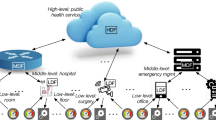Abstract
In order to explore the data fusion algorithm in medical Internet of things, the monitoring of medical data in the Internet of things is discussed and studied focusing on data fusion and related routing technology. According to the particularity of the data in the medical Internet of things, a data fusion cluster-tree construction algorithm based on event-driven (DFCTA) is proposed. The fusion delay problem in the network is analyzed, and the minimum fusion delay method is proposed by calculation of the fusion waiting time of the nodes. Finally, the intelligent health management data fusion system in the medical Internet of things is designed. Aiming at the characteristics of multilevel integration of multisource heterogeneous data fusion for intelligent health management, the data fusion architecture of fusion tree composed of fusion nodes is proposed. The experiment shows that the DFCTA algorithm has good fusion performance. Based on the above findings, it is concluded that the algorithm is a fast and reliable method, which has important practical significance.






Similar content being viewed by others
References
Zhang W, Thurow K, Stoll R (2014) A knowledge-based telemonitoring platform for application in remote healthcare. Int J Comput Commun 9(5):644
Dong J, Zhuang D, Huang Y et al (2009) Advances in multi-sensor data fusion: algorithms and applications. Sensors 9(10):7771
Gevaert CM, García-Haro FJ (2015) A comparison of STARFM and an unmixing-based algorithm for Landsat and MODIS data fusion. Remote Sens Environ 156:34–44
Fourati H (2014) Heterogeneous data fusion algorithm for pedestrian navigation via foot-mounted inertial measurement unit and complementary filter. IEEE Trans Instrum Meas 64(1):221–229
Ambuehl L, Menendez M (2016) Data fusion algorithm for macroscopic fundamental diagram estimation. Transp Res Part C Emerg Technol 71:184–197
Zhang W, Thurow K, Stoll RA (2014) A context-aware mHealth system for online physiological monitoring in remote healthcare. Int J Comput Commun 11(1):142–156
Chiou YS, Tsai F (2014) A reduced-complexity data-fusion algorithm using belief propagation for location tracking in heterogeneous observations. IEEE T Cybernetics 44(6):922
Błachuta M, Czyba R, Janusz W et al (2014) Data fusion algorithm for the altitude and vertical speed estimation of the VTOL platform. J Intell Robot Syst 74(1–2):413–420
Xia Y, Leung H (2014) A fast learning algorithm for blind data fusion using a novel -norm estimation. IEEE Sensors J 14(3):666–672
Kumar M, Mao Y, Wang Y, Qiu T, Yang C, Zhang W (2017) Fuzzy theoretic approach to signals and systems: static systems. Inf Sci 418:668–702
Quadri SA, Sidek O (2013) Role of algorithm engineering in data fusion algorithms. J Comput Intell Electron Syst 2(1):1–7
Huang HP, Chen JT, Wang RC et al (2014) Compressed sensing algorithm based on data fusion tree in wireless sensor networks. J Electron Inf Technol 36(10):2364–2369
Jiang W, Li Y, Rizos C (2015) Optimal data fusion algorithm for navigation using triple integration of PPP-GNSS, INS, and terrestrial ranging system. IEEE Sensors J 15(10):5634–5644
Novelli A, Tarantino E, Fratino U et al (2016) A data fusion algorithm based on the Kalman filter to estimate leaf area index evolution in durum wheat by using field measurements and MODIS surface reflectance data. Remote Sens Lett 7(5):476–484
Shu J, Hong M, Zheng W et al (2013) Multi-sensor data fusion based on consistency test and sliding window variance weighted algorithm in sensor networks. Computer Science & Information Systems 10(1):197–214
Funding
The authors acknowledge the National Natural Science Foundation of China (Grant: 61662045), the Special Program of Talents Development for Excellent Youth Scholars in Tianjin.
Author information
Authors and Affiliations
Corresponding author
Rights and permissions
About this article
Cite this article
Zhang, W., Yang, J., Su, H. et al. Medical data fusion algorithm based on Internet of things. Pers Ubiquit Comput 22, 895–902 (2018). https://doi.org/10.1007/s00779-018-1173-y
Received:
Accepted:
Published:
Issue Date:
DOI: https://doi.org/10.1007/s00779-018-1173-y




